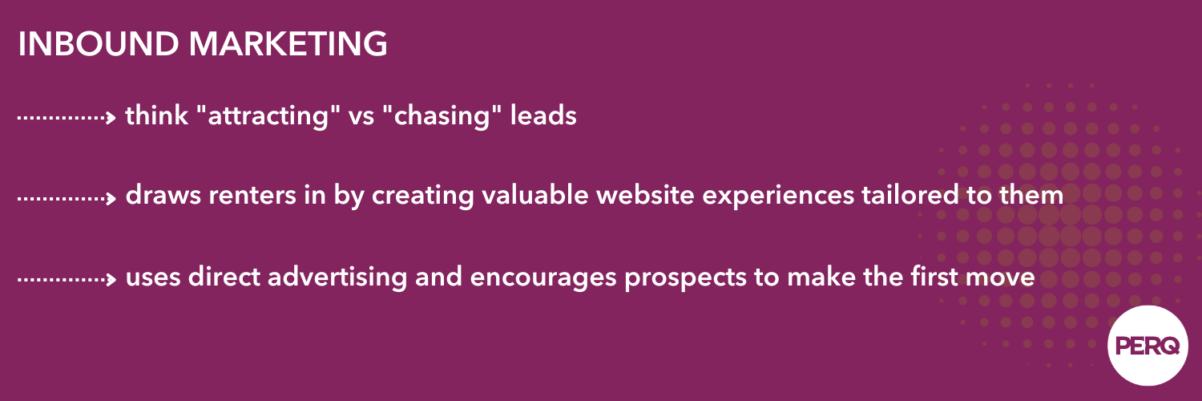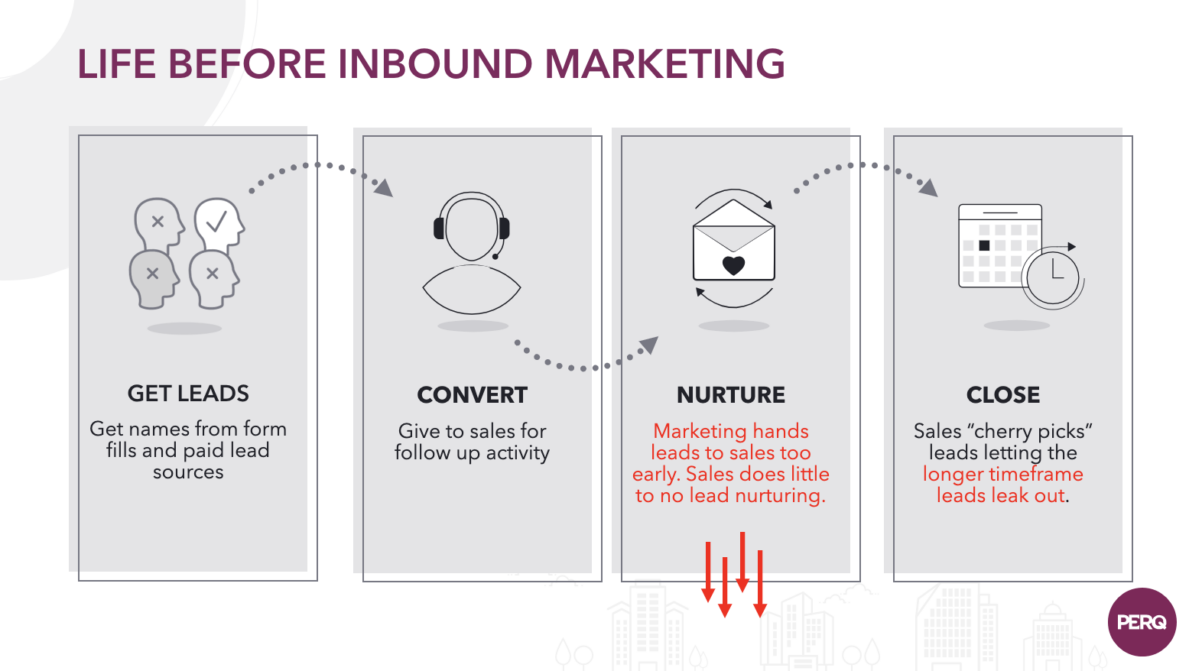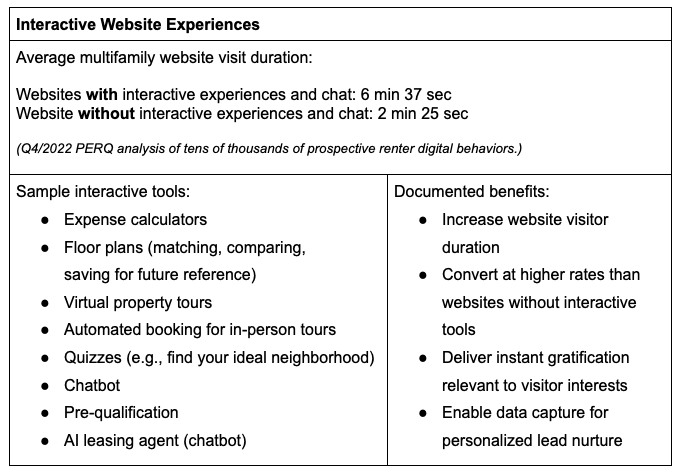There are currently 22 million apartment units in the United States and recent estimates say new supply is growing at an average of about 426,000 units a year. That said, the competition to sign leases is fierce. Outside of location, apartment marketers’ strategy to win has historically been through differentiation, creating what has been called the “amenities arms race”. However, at this point, competing properties now have a pretty similar set of amenities. Recent surveys indicate that the living experience for the renter hasn’t improved dramatically. And, so, like other industries, when differentiation erodes, the focus starts to shift to service or experience.

At no time in history has this been more of a problem than now, where digital experiences and what happens BEFORE a prospective renter even sees your property is the biggest driver of a person’s willingness to tour or rent. Today, we are living in an experience economy and multifamily cannot afford to be left behind due to not creating modern-day digital experiences. This puts a lot of pressure on digital inbound marketing strategies for multifamily marketers. Whether you’re a new or seasoned multifamily marketer, chances are you’ve been scratching your head lately and questioning how to best attract, convert and retain renters to your multifamily properties.
They need to be prepared to provide the personalized experiences, triggered communications, and instant gratification today’s rental prospects want and have come to expect from their experiences working with online consumer brands. Consumer expectations are creating a new paradigm for multifamily marketing, one that must focus on inbound marketing in order to deliver the results PMCs need.
There’s a generational shift happening too. A lot of our renters are now younger, and they’re used to a more automated experience and the instant gratification that comes with that. They don’t want to talk to anyone on the phone, ever. They would much rather have a chatbot experience or have somebody emailing or texting.
Meagan Struve, Marketing Analyst, Mission Rock
The past couple of years have been a season of dramatic transition in consumer behaviors, digital habits, and renter journeys. That rapid transformation will continue as AI advancements fuel new automation, access and conveniences, reshaping consumer expectations once again. A focus on creating modern digital experiences helps your website to appeal to diverse renter interests at various stages of their renter’s journey. All the work necessary to create these good online experiences for prospects also has a massive payoff because digital marketing offers more measurable value than other methods.
Traditional methods, like print advertising or direct mail, bring prospective renters in ways that are difficult to track or need manual tracking, whereas multifamily digital marketing offers measurable results. And the good news is, multifamily inbound marketing offers three times more leads per dollar than traditional methods, and inbound leads cost 61% less on average. The measurable nature of the results is one of the important values that inbound marketing offers marketers and goes far beyond improving the experience on the renters’ journey.
Inbound Marketing in a Snapshot
Put simply, an inbound marketing strategy is the process of attracting prospects, encouraging them to make the first move, then fueling buying intent with personalized nurture.
A high-performing inbound marketing program typically includes four components:
- Capturing the attention of potential renters.
- Compelling them to share their personal information (i.e., lead capture) by exchanging that info for valuable resources (helpful content, interactive tools) on your website and digital channels.
- Nurturing leads with automated messaging that’s personalized to their preferences, engagement behaviors, and other interests they have revealed about themselves.
- Passing only leads that are ready for a real buying conversation to the sales team.

Item #4 above is one that many marketers get wrong and see their efforts flop, so let’s expand on it: When marketers hand leads to leasing agents too early (that is, before they’ve had a chance to drive engagement and buying intent), leasing agents invariably cherry-pick leads, putting some on hold or letting others fall through the cracks without follow-up. In multifamily, roughly 20% of apartment rental leads go ignored — a practice that adds up quickly when leads can cost upward of $50 each.

Rather than treating all leads as equal, inbound marketing shoulders the responsibility of qualifying and warming up leads before passing them on to sales.
In this model, leasing agents focus on tours, lease applications and signings with high-intent prospects, while inbound marketing automation does all the rest, from lead capture to nurture and on-demand support.

Digital Inbound Marketing Tools Work Together to Get the Lease
Consider a multifamily marketer trying to lease a newly constructed apartment building. The marketer could choose to work with an ILS (Internet Listing Service) to obtain leads and then do some email marketing to them just like every other property does every other time. However, they could also choose to take their marketing efforts up a notch by employing a multifamily inbound marketing strategy that leverages a variety of various methods to maximize the educational experience of a prospect, pulling all their leads through their website as the ultimate hub of their marketing efforts.
Inbound marketing tactics generate 54% more leads than traditional paid marketing methods.
Source: Hubspot
For example, an enticing social media post might have a call-to-action (CTA) to read a blog post describing the benefits of the location of the property that has a CTA to a special offer. Once they complete the form to get the offer content sent, you can utilize marketing automation to continue nurturing them via email using content to move that prospect towards a tour.
Or, the property website could employ interactive website conversion tools where the prospects can interact with the tools to learn more about the community. The information they supply during these experiences can be used to further tailor nurture communications and outreach to them. In fact, a recent study showed that property sites with interactive website tools booked 32% more tours than those without. In all, interactive property websites captured 622% more leads than those that only offer a “book a tour” option, showing clear benefits of a more engaging website.
Automatic Lead Capture and Nurture with AI
With that overview out of the way, what does it take to compel those self-led searchers to share their contact info, or even reveal personal moving plans and preferences?
Increasingly, it comes down to your website’s ability to deliver the types of “made-for-me” experiences consumers routinely enjoy from their favorite retail and entertainment platforms: instant answers personalized to their interests.
Interactive quizzes, calculators, floor plan matches, AI chatbots, virtual tours, and how-to guides are some of the ways you can sway visitors to share their contact information so you can follow up later, nudging them to return and take the next step.

Once you’ve captured prospect information, multifamily automation technology can take that info and tailor nurture communications (email, SMS) that’s relevant to each prospect’s interests, website behaviors, and other insights you’ve captured via interactive tools.
Allow us to stress one important point: Your lead nurture can only be as personalized as the data you have, which is why those early website experiences are so important. As you capture more information about each lead, you’re then able to customize a myriad of nurture communications, including:
- The cadence of touches based on the renter’s move-in window
- Content-based on preferred floor plans or budget
- Content-based on other preferences like how your community supports pets, disability access, fitness or community areas, for example
- Nudging next steps based on the prospect’s last recorded behaviors
- Availability notifications for units that match their interests
- Follow up on themes or questions they asked your chatbot
How effective can lead nurture be in times of slow demand? Let’s consider Q4, 2022 — a period when multifamily properties experienced a dip in move-ins. Even so, we saw the influence of lead nurture grow from Q3 (28.85%) to Q4 (39.26%) with more move-ins responding to nurture efforts during the hustle and bustle of the holiday season.
Supporting the Numbers
While marketers continuously seek ways to reach their goals efficiently, most executives only care about the numbers. This is another area where multifamily inbound marketing offers strong value. Calculating ROI, cost per lead, and customer acquisition cost is simplified when using inbound methods, as the data can be tracked easily, particularly if you have a way to track lead source attribution. The bonus? Inbound marketing, when one properly, can significantly improve your marketing ROI (Return on Investment).
Consider cost per lead: It’s as simple as knowing your ad spend and dividing it by total leads.
Cost Per Lead (CPL) = Total Marketing Spend /Total Leads
If you want to understand your cost down funnel, you can calculate cost per tour. To do so, you would just need to divide your marketing spend by the number of tours.
For marketers looking for more comprehensive figures, cost per lease can show the value of each resident your marketing efforts helped obtain. For this, you simply divide your marketing spend by number of new leases driven by marketing activity.
Earlier in this article, it was mentioned that inbound leads cost 61% less on average. Study after study says the same. The reason is primarily because marketers who use inbound marketing generate more leads than those not using it. Providing consistent content across multiple inbound channels means more changes your target renters get to discover your community. But it’s also been shown that leads generated through inbound marketing have a higher chance of converting to a lease.
According to inbound marketing statistics, leads obtained with SEO (Search Engine Optimization) have a win rate of 14.6 percent as opposed to just 1.7 percent with outbound. And these leads have little to no cost. If you’re getting more of your leads without paying a lead source, you’re driving down your marketing spend.
Multifamily Case Study: 90-Day Results
Marketing leaders at Laramar Group, a Chicago-based property management group, were looking to revamp their inbound marketing and lead management. With limited staff and lots of leads, Laramar teams were struggling to keep up and discern high-value leads from low-value ones, spending a ton of time on low-impact activities like answering FAQs. Good leads were slipping through the cracks and the team was frazzled trying to juggle the volume of inquiries and unqualified leads coming at them.
Laramar decided to pilot PERQ at select properties for 90 days, then compare results against metrics from the previous year for the same properties.
Initially, the Laramar team had been focused on an AI chatbot capability to manage FAQs on its websites. With PERQ, they realized the conversational AI component could also learn from each interaction to customize nurture communications. The more users interacted with the property’s website and inbound marketing channels, the more the AI learned, and the more it could use that intel to personalize messaging, cadence, calls-to-action, and more.
Three months later, Laramar reported:
- 182% increase in lead-to-tour conversions
- 113% increase in website traffic to lead conversion
- 90.4% of tours scheduled via website interactive tools, requiring zero human interaction
- 2,858 fewer hours spent managing leads, equating to $57,160 in payroll value
- $43,116 in savings or cost avoidance in lead generation (more sales generated from website traffic, plus more tours from nurtured leads)
Our conversion rates went up and we saw an immediate impact on the team. We began getting positive feedback from site teams that they no longer have to spend time to figure out which are the hottest leads because now they’re getting qualified tours…We’ve been running under budget on marketing by a couple thousand dollars a month.
Anna Shea, Senior Director of Marketing, Laramar Group
What a difference, and in just 90 days! Laramar’s results aren’t isolated examples. Rather, they’re consistent with what we’ve seen with many multifamily marketing programs applying the inbound marketing approach we’ve shared. (Hear from other multifamily marketers in their own words, here.)
With the right lead nurture automation and personalized nurture tools, your multifamily team can supercharge renter conversions and onsite team performance. You might even reduce spending and workload significantly, all while delighting prospective renters. It’s the beauty of blending AI-powered automation and personalization with human talent to get the best of both worlds.
An All-Encompassing Multifamily Marketing Solution
It can be tempting for multifamily marketers to rely on the tools of traditional advertising. For a long time, the multifamily business was mostly conducted face-to-face and the marketing efforts primarily included leveraged radio ads and billboards. However, multifamily inbound marketing efforts offer a true and marked improvement in ROI. And, in a competitive leasing market, that’s just going to continue to get more intense — anything to set yourself apart should be embraced.
Visit perq.com to learn how marketing automation can help enhance your inbound marketing efforts.